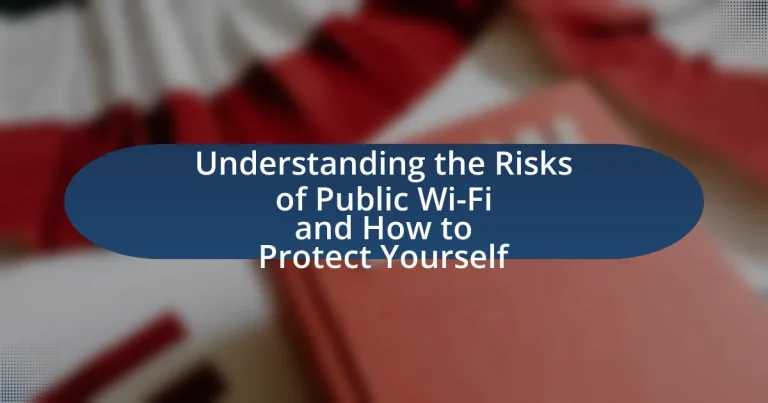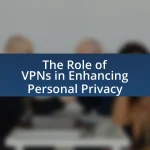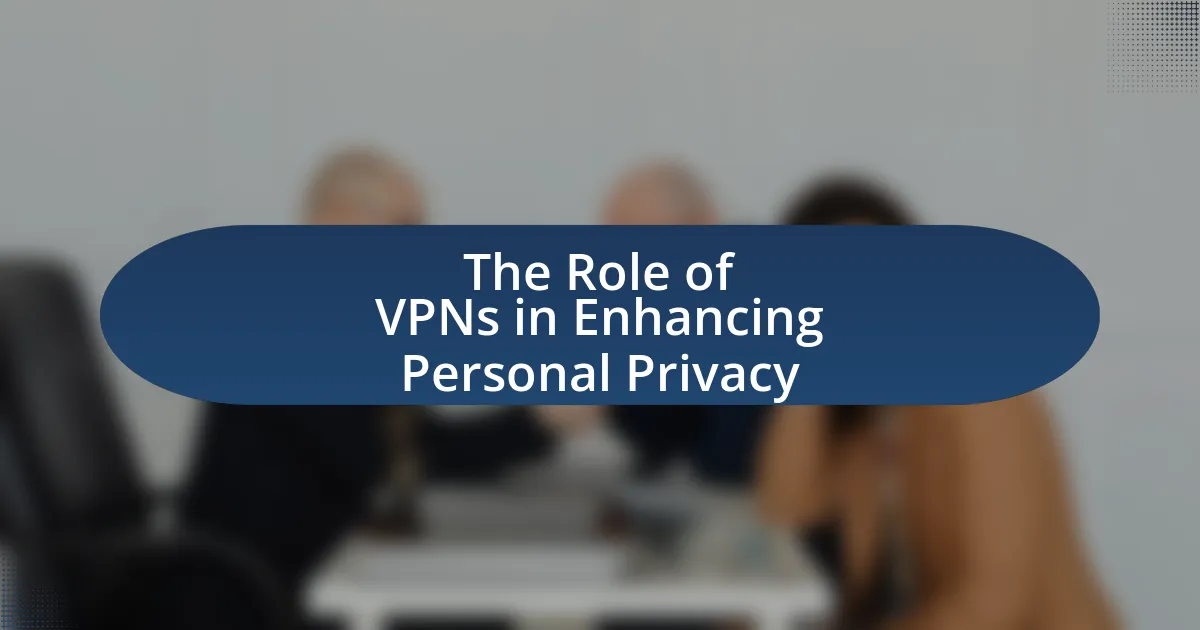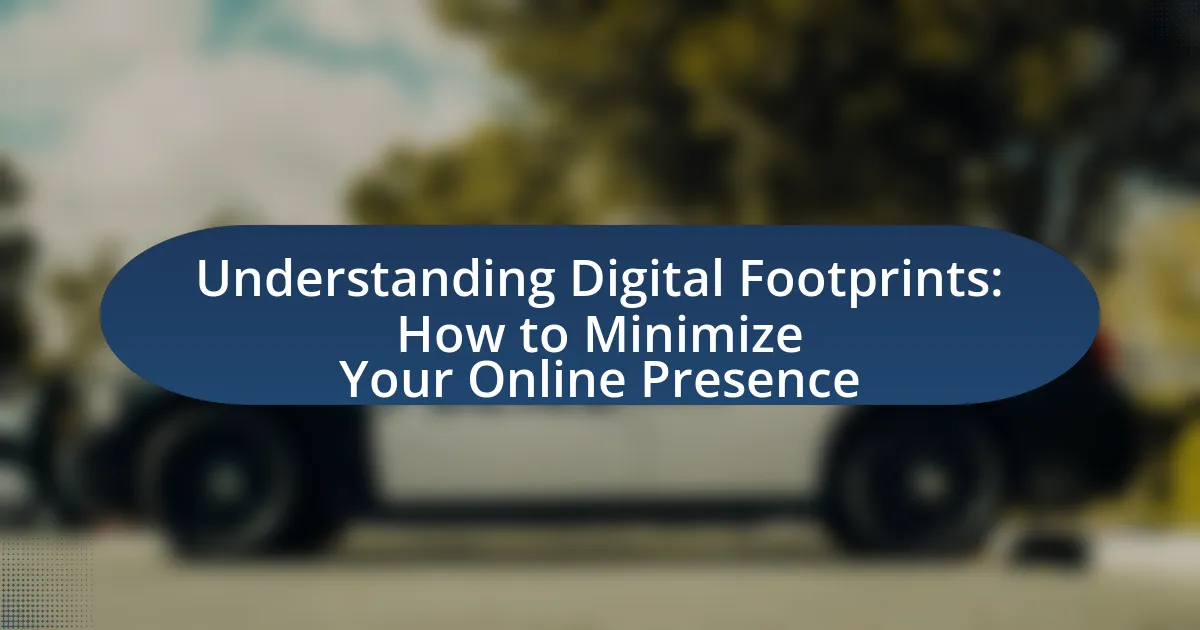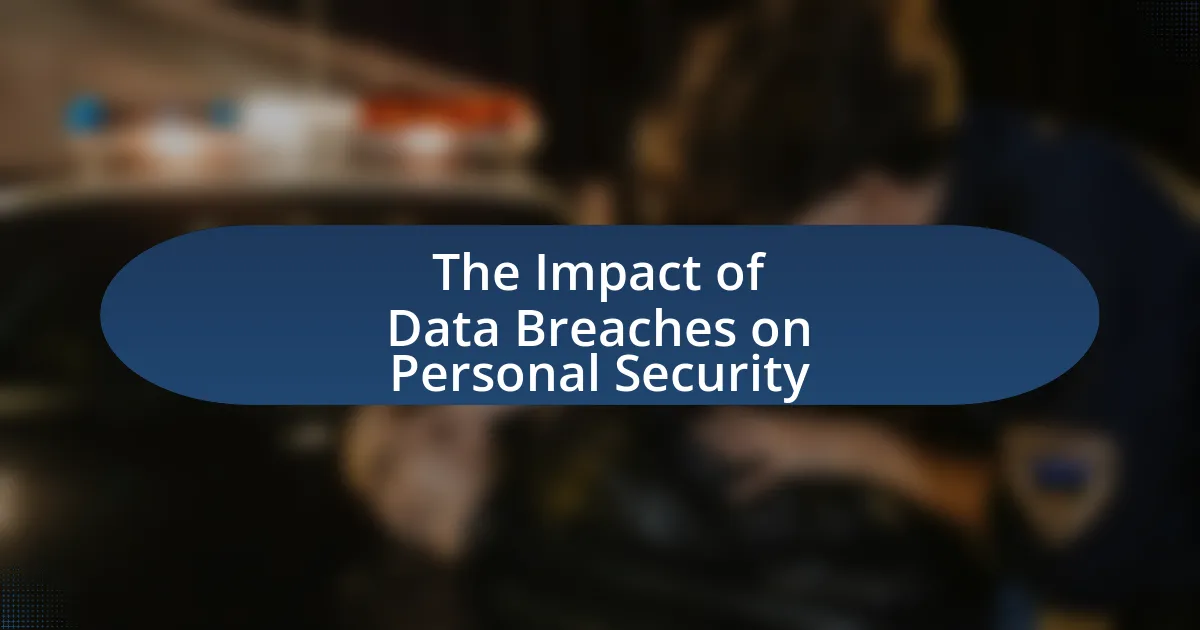Public Wi-Fi networks present significant security risks, including data interception, malware distribution, and man-in-the-middle attacks. Cybercriminals exploit these vulnerabilities through techniques such as packet sniffing and rogue hotspots, making personal information like passwords and financial data susceptible to theft. The article outlines the importance of encryption, the role of VPNs, and best practices for safe usage of public Wi-Fi, emphasizing the need for users to adopt proactive measures to protect their sensitive information. Additionally, it discusses the implications of identity theft and provides guidance on recognizing and responding to potential security breaches.
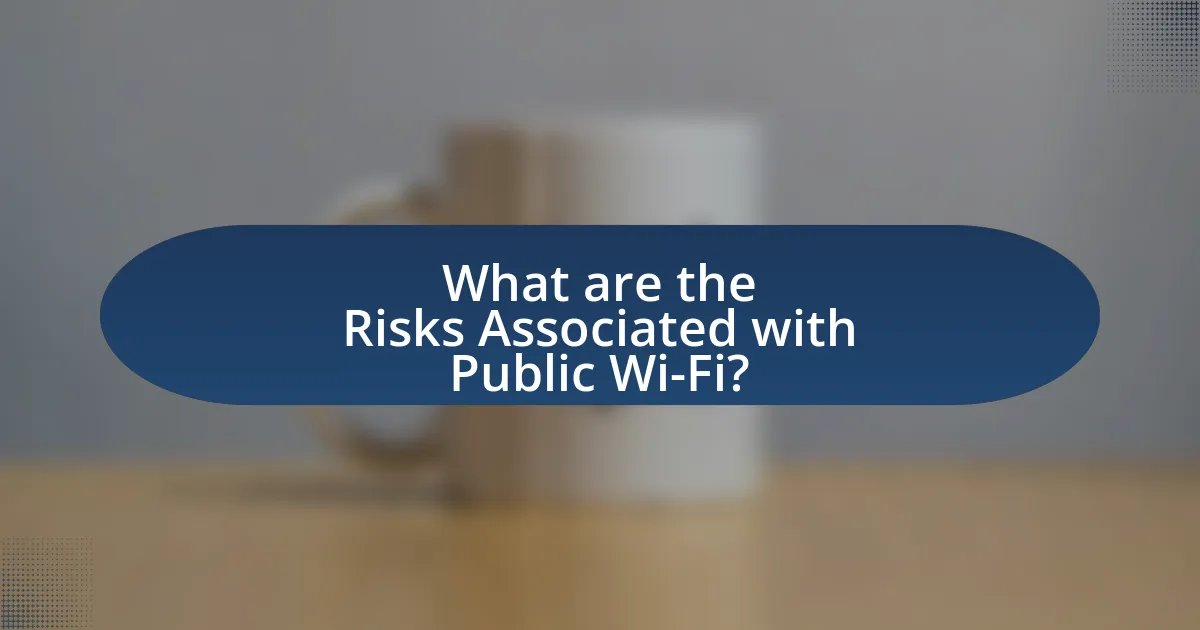
What are the Risks Associated with Public Wi-Fi?
Public Wi-Fi poses several risks, primarily including data interception, malware distribution, and man-in-the-middle attacks. Data interception occurs when cybercriminals use tools to capture unencrypted data transmitted over public networks, potentially exposing sensitive information such as passwords and personal details. According to a study by the Federal Trade Commission, 70% of public Wi-Fi networks do not encrypt data, making users vulnerable to such attacks. Malware distribution can happen when users connect to rogue hotspots that mimic legitimate networks, allowing attackers to install malicious software on devices. Additionally, man-in-the-middle attacks enable hackers to intercept communications between the user and the intended server, further compromising data security. These risks highlight the importance of exercising caution when using public Wi-Fi.
How do hackers exploit public Wi-Fi networks?
Hackers exploit public Wi-Fi networks primarily through techniques such as man-in-the-middle attacks, packet sniffing, and rogue hotspots. In man-in-the-middle attacks, hackers intercept communications between users and the network, allowing them to capture sensitive information like passwords and credit card numbers. Packet sniffing involves monitoring data packets transmitted over the network, which can reveal unencrypted personal data. Rogue hotspots are fake Wi-Fi networks set up by hackers to lure unsuspecting users, who unknowingly connect and expose their data. According to a report by the Federal Trade Commission, over 60% of public Wi-Fi networks lack basic security measures, making them vulnerable to these types of attacks.
What techniques do cybercriminals use to intercept data?
Cybercriminals use techniques such as packet sniffing, man-in-the-middle attacks, and rogue access points to intercept data. Packet sniffing involves capturing data packets transmitted over a network, allowing attackers to access sensitive information like passwords and credit card numbers. Man-in-the-middle attacks occur when a cybercriminal secretly relays and possibly alters the communication between two parties, making it appear as if a normal exchange is taking place. Rogue access points are unauthorized Wi-Fi hotspots set up by attackers to lure unsuspecting users, enabling them to capture any data transmitted over the connection. These methods exploit vulnerabilities in public Wi-Fi networks, making users’ data susceptible to interception.
How can malware spread through public Wi-Fi?
Malware can spread through public Wi-Fi by exploiting unsecured networks, allowing attackers to intercept data and inject malicious software into connected devices. When users connect to an open or poorly secured Wi-Fi network, their devices become vulnerable to man-in-the-middle attacks, where cybercriminals can capture sensitive information or distribute malware. According to a study by the Federal Trade Commission, 87% of public Wi-Fi networks lack adequate security measures, making them prime targets for malware distribution.
What personal information is at risk when using public Wi-Fi?
When using public Wi-Fi, personal information at risk includes login credentials, financial data, and sensitive communications. Cybercriminals can intercept data transmitted over unsecured networks, allowing them to access usernames, passwords, credit card numbers, and private messages. According to a report by the Federal Trade Commission, over 40% of consumers have experienced identity theft, often linked to unsecured Wi-Fi connections. This highlights the vulnerability of personal information when using public networks.
How can sensitive data be compromised on unsecured networks?
Sensitive data can be compromised on unsecured networks through various methods such as eavesdropping, man-in-the-middle attacks, and packet sniffing. Eavesdropping occurs when attackers intercept unencrypted data transmitted over the network, allowing them to capture sensitive information like passwords and credit card numbers. Man-in-the-middle attacks involve an attacker secretly relaying and possibly altering the communication between two parties, making it appear legitimate while stealing data. Packet sniffing enables attackers to analyze data packets sent over the network, extracting sensitive information without the user’s knowledge. According to a study by the Federal Trade Commission, over 70% of public Wi-Fi networks lack adequate security measures, increasing the risk of data compromise significantly.
What are the implications of identity theft via public Wi-Fi?
Identity theft via public Wi-Fi can lead to severe financial loss, reputational damage, and legal complications for victims. When individuals connect to unsecured public networks, cybercriminals can intercept sensitive information such as passwords, credit card numbers, and personal identification details. According to a report by the Federal Trade Commission, identity theft affected over 1.4 million consumers in 2020, with many cases linked to unsecured internet connections. This highlights the significant risk posed by public Wi-Fi, as attackers can easily exploit vulnerabilities to gain unauthorized access to personal data.
Why is encryption important for public Wi-Fi security?
Encryption is crucial for public Wi-Fi security because it protects sensitive data from unauthorized access. When users connect to public Wi-Fi networks, their data can be intercepted by malicious actors if not encrypted. For instance, encryption protocols like WPA2 and WPA3 secure the communication between devices and the network, making it significantly harder for attackers to eavesdrop or steal personal information. According to a study by the Federal Trade Commission, unencrypted Wi-Fi networks are a common target for cybercriminals, highlighting the necessity of encryption to safeguard user data against potential breaches.
What types of encryption should users look for?
Users should look for WPA3 encryption when connecting to public Wi-Fi networks, as it provides enhanced security features compared to its predecessor, WPA2. WPA3 employs stronger encryption protocols, making it more resistant to brute-force attacks and ensuring better protection of user data. Additionally, users should seek out VPN (Virtual Private Network) services that utilize strong encryption standards, such as AES-256, which is widely recognized for its robustness in securing internet traffic. These encryption types significantly reduce the risk of data interception and unauthorized access while using public Wi-Fi.
How does encryption protect data transmitted over public networks?
Encryption protects data transmitted over public networks by converting the information into a coded format that is unreadable to unauthorized users. This process ensures that even if data is intercepted during transmission, it remains secure and confidential, as only authorized parties with the correct decryption key can access the original content. For instance, protocols like HTTPS and VPNs utilize encryption to safeguard sensitive information, such as passwords and personal data, from potential eavesdroppers on public Wi-Fi networks. According to a study by the Ponemon Institute, 60% of data breaches occur due to unsecured networks, highlighting the critical role of encryption in mitigating these risks.

How Can You Protect Yourself on Public Wi-Fi?
To protect yourself on public Wi-Fi, use a Virtual Private Network (VPN) to encrypt your internet connection. A VPN creates a secure tunnel for your data, making it difficult for hackers to intercept your information. According to a study by the Federal Trade Commission, public Wi-Fi networks are often unsecured, allowing cybercriminals to access sensitive data such as passwords and credit card numbers. Additionally, avoid accessing sensitive accounts or conducting financial transactions while connected to public Wi-Fi, as this increases the risk of data theft.
What are the best practices for using public Wi-Fi safely?
To use public Wi-Fi safely, always connect through a Virtual Private Network (VPN) to encrypt your internet traffic. This practice protects your data from potential eavesdroppers on unsecured networks. Additionally, avoid accessing sensitive information, such as banking details or personal accounts, while connected to public Wi-Fi, as these networks are often less secure. Furthermore, ensure that your device’s firewall is enabled and that your software is up to date to protect against vulnerabilities. According to a study by the Federal Trade Commission, using a VPN can significantly reduce the risk of data interception on public networks, highlighting its importance in safe browsing practices.
How can a VPN enhance your security on public networks?
A VPN enhances your security on public networks by encrypting your internet connection, which protects your data from potential eavesdroppers. When using public Wi-Fi, your information is vulnerable to interception by hackers; however, a VPN creates a secure tunnel for your data, making it unreadable to anyone who might attempt to access it. According to a study by the University of Maryland, 85% of public Wi-Fi networks are unsecured, highlighting the necessity of using a VPN to safeguard sensitive information such as passwords and personal details.
What settings should you adjust on your device for better security?
To enhance security on your device, adjust the Wi-Fi settings to connect only to secure networks and disable automatic connections to open networks. This prevents unauthorized access and reduces the risk of data interception. Additionally, enable the firewall and ensure that your operating system and applications are updated regularly to protect against vulnerabilities. According to the Cybersecurity & Infrastructure Security Agency, keeping software updated is crucial as it addresses known security flaws, thereby reinforcing device security.
What tools and software can help secure your connection?
VPNs (Virtual Private Networks) are essential tools that can help secure your connection when using public Wi-Fi. They encrypt your internet traffic, making it difficult for hackers to intercept your data. For instance, services like NordVPN and ExpressVPN utilize strong encryption protocols, ensuring that your online activities remain private. Additionally, firewalls, such as those built into Windows and macOS, provide an extra layer of security by monitoring incoming and outgoing traffic to block unauthorized access. Antivirus software, like Norton or McAfee, also plays a crucial role by detecting and preventing malware that could compromise your connection. These tools collectively enhance your security posture while using public networks.
How do antivirus programs contribute to public Wi-Fi safety?
Antivirus programs enhance public Wi-Fi safety by detecting and blocking malware, phishing attempts, and other cyber threats that can exploit unsecured networks. These programs continuously scan for malicious software and suspicious activities, providing real-time protection against potential attacks. For instance, according to a report by the Cybersecurity & Infrastructure Security Agency, using antivirus software can reduce the risk of malware infections by up to 70% on public networks. This proactive defense mechanism helps safeguard sensitive information, such as passwords and personal data, from cybercriminals who often target users on public Wi-Fi.
What role do firewalls play in protecting your data?
Firewalls serve as a critical barrier between your internal network and external threats, effectively protecting your data from unauthorized access and cyberattacks. By monitoring and controlling incoming and outgoing network traffic based on predetermined security rules, firewalls can block malicious traffic and prevent data breaches. For instance, according to a report by the Cybersecurity & Infrastructure Security Agency, organizations that implement firewalls can reduce the risk of data compromise by up to 80%. This demonstrates the essential role firewalls play in safeguarding sensitive information, especially when using public Wi-Fi, where the risk of exposure to cyber threats is significantly heightened.
Why is it important to avoid sensitive transactions on public Wi-Fi?
It is important to avoid sensitive transactions on public Wi-Fi because these networks are often unsecured, making it easy for cybercriminals to intercept data. Public Wi-Fi lacks encryption, which means that personal information, such as passwords and credit card numbers, can be accessed by anyone within range using simple hacking tools. According to a study by the Federal Trade Commission, 70% of public Wi-Fi networks are vulnerable to attacks, highlighting the significant risk of data theft. Therefore, conducting sensitive transactions on these networks can lead to identity theft and financial loss.
What types of transactions should be avoided?
Transactions that should be avoided on public Wi-Fi include any financial transactions, such as online banking, shopping, or entering credit card information. These activities are particularly vulnerable to interception by cybercriminals who can exploit unsecured networks to capture sensitive data. According to a study by the Federal Trade Commission, over 30% of identity theft cases involve unauthorized access to financial accounts, highlighting the risks associated with conducting such transactions on public Wi-Fi.
How can you identify secure websites before entering personal information?
To identify secure websites before entering personal information, look for URLs that begin with “https://” instead of “http://”. The “s” in “https” indicates that the website uses SSL (Secure Socket Layer) encryption, which protects data during transmission. Additionally, check for a padlock icon in the address bar, which signifies that the connection is secure. According to a study by the Online Trust Alliance, 84% of users are more likely to trust a website that displays these security indicators.
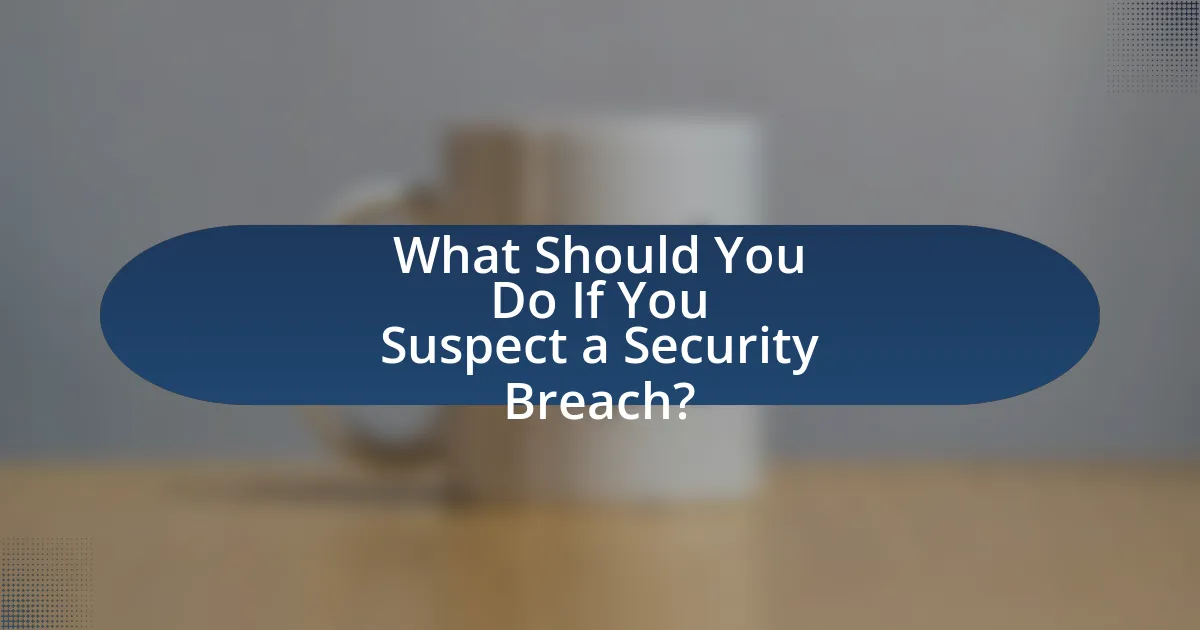
What Should You Do If You Suspect a Security Breach?
If you suspect a security breach, immediately disconnect from the network to prevent further unauthorized access. This action halts any ongoing data transmission and limits potential damage. Next, change your passwords for all accounts accessed over the network, as compromised credentials can lead to identity theft or unauthorized transactions. Additionally, run a comprehensive antivirus scan on your devices to detect and remove any malware that may have been installed during the breach. According to the Cybersecurity & Infrastructure Security Agency, timely response actions can significantly mitigate the impact of a security incident. Finally, report the breach to your service provider and relevant authorities to aid in investigation and prevention efforts.
How can you recognize signs of a potential security breach?
You can recognize signs of a potential security breach by monitoring for unusual account activity, unexpected software installations, and unauthorized access attempts. Unusual account activity may include login attempts from unfamiliar locations or devices, which can indicate that someone else is trying to access your account. Unexpected software installations, especially those that you did not initiate, can signal malware presence. Unauthorized access attempts can be identified through alerts from security systems or notifications from service providers about failed login attempts. These indicators are critical as they reflect common patterns associated with security breaches, emphasizing the need for vigilance when using public Wi-Fi networks.
What unusual behaviors should you look for on your device?
Unusual behaviors to look for on your device include unexpected pop-ups, slow performance, and unfamiliar applications. These signs may indicate malware or unauthorized access, especially when using public Wi-Fi, which is often less secure. For instance, a study by the Federal Trade Commission highlights that public Wi-Fi networks can expose devices to various cyber threats, making it crucial to monitor for these anomalies. Additionally, if your device begins to send messages or make calls without your consent, this is a strong indicator of potential compromise.
How can you check for unauthorized access to your accounts?
To check for unauthorized access to your accounts, regularly review your account activity and security settings. This includes monitoring login history, which many services provide, to identify any unfamiliar locations or devices. Additionally, enable two-factor authentication, which adds an extra layer of security and alerts you to any unauthorized login attempts. According to a 2021 report by the Identity Theft Resource Center, 1 in 4 Americans experienced identity theft, highlighting the importance of vigilance in monitoring account access.
What steps should you take immediately after a suspected breach?
Immediately after a suspected breach, you should disconnect the affected device from the network to prevent further unauthorized access. This action limits the potential damage and stops any ongoing data exfiltration. Next, you should assess the extent of the breach by reviewing logs and identifying compromised accounts or systems. Following this, change passwords for affected accounts and enable two-factor authentication where possible to enhance security. Additionally, notify your IT department or a cybersecurity professional to investigate the breach and implement necessary remediation steps. According to the Cybersecurity & Infrastructure Security Agency (CISA), prompt action can significantly reduce the impact of a breach, emphasizing the importance of immediate response measures.
How can you secure your accounts and devices post-breach?
To secure your accounts and devices post-breach, immediately change your passwords for all affected accounts and enable two-factor authentication (2FA) where available. Changing passwords reduces the risk of unauthorized access, while 2FA adds an additional layer of security by requiring a second form of verification. According to a 2021 report by the Cybersecurity & Infrastructure Security Agency, implementing 2FA can block up to 99.9% of automated attacks. Additionally, review account activity for any unauthorized transactions and consider using a password manager to generate and store complex passwords securely. Regularly update your software and devices to patch vulnerabilities, as outdated systems are more susceptible to breaches.
What should you report to authorities or service providers?
You should report any suspicious activity or security breaches encountered while using public Wi-Fi to authorities or service providers. This includes unauthorized access to your personal information, unusual account activity, or any signs of identity theft. Reporting these incidents helps protect not only your data but also assists in preventing further attacks on others. For instance, the Federal Trade Commission advises users to report identity theft to the Identity Theft Hotline, which can provide guidance and support in such situations.
What are the long-term strategies for maintaining security on public Wi-Fi?
Long-term strategies for maintaining security on public Wi-Fi include using a Virtual Private Network (VPN), enabling two-factor authentication, and regularly updating devices and software. A VPN encrypts internet traffic, making it difficult for attackers to intercept data, while two-factor authentication adds an extra layer of security by requiring a second form of verification. Regular updates ensure that devices are protected against known vulnerabilities, as software developers frequently release patches to address security flaws. These strategies collectively enhance user security and mitigate risks associated with public Wi-Fi networks.
How can regular updates and patches improve your security posture?
Regular updates and patches significantly enhance your security posture by addressing vulnerabilities that could be exploited by attackers. These updates often include fixes for known security flaws, which, if left unpatched, can lead to unauthorized access, data breaches, or malware infections. For instance, according to a report by the Ponemon Institute, 60% of data breaches are linked to unpatched vulnerabilities. By consistently applying updates, organizations can reduce their attack surface and protect sensitive information, particularly when using public Wi-Fi networks, which are inherently less secure.
What habits can you develop to enhance your overall online safety?
To enhance your overall online safety, develop habits such as using strong, unique passwords for each account, enabling two-factor authentication, and regularly updating software and devices. Strong passwords reduce the risk of unauthorized access, as studies show that 81% of data breaches are linked to weak passwords. Two-factor authentication adds an extra layer of security, making it harder for attackers to gain access even if they have your password. Regular updates patch vulnerabilities, as 60% of breaches exploit known vulnerabilities that could have been fixed with timely updates. Additionally, avoid using public Wi-Fi for sensitive transactions, as unsecured networks can expose your data to cybercriminals.
